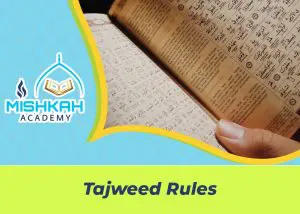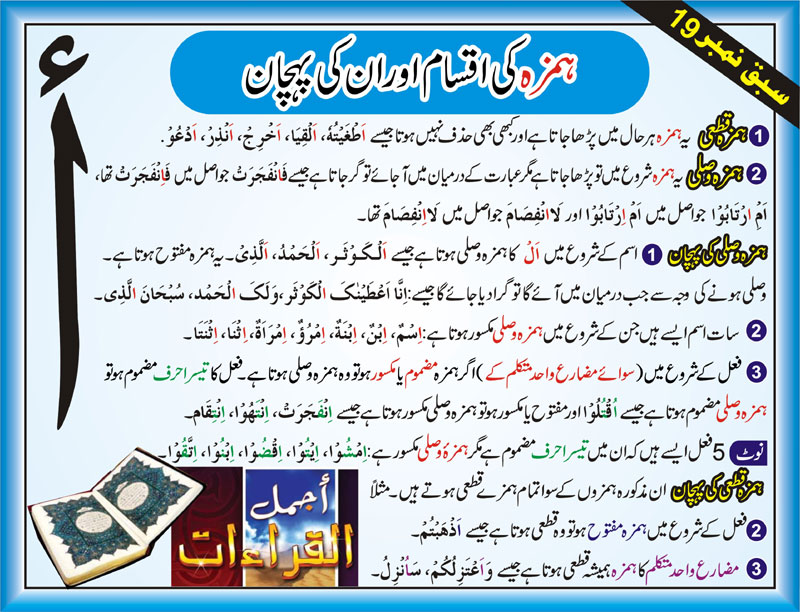Learn Quran, Arabic & Islamic Online
Hamzatul Wasl And Qat
Table of Contents
ToggleOne of the main benefits of learning the Qur’an with Tajweed is mentioned in the hadith of the Prophet “Those who can recite the Qur’an accurately and precisely will attain the highest ranks in Heaven” because the Holy Qur’an is the only book that its recitation is considered a form of worship with great reward. No other book or letter fits this description.
It is expected of every Muslim to read the Qur’an correctly as much as he can and in the correct way that was revealed to our Holy Prophet. Moving on to the article, we will study all the rules of Mim Sakina to the best of our ability.
Allah The Almighty said:
“And recite the Qur’an with a chant”, i.e., do not rush to read the Qur’an, but rather read it slowly and clearly while reflecting on the meanings.
Messenger of Allah (PBUH) said:
“The one who is proficient with the Qur’an will be with the noble and righteous scribes (the angels), and the one who reads it and stumbles over it, finding it difficult, will have two rewards.”
Ibn Al-Jazari also “Most Famous Tajweed Scholar” said:
“The practical application of Tajweed is without doubt compulsory. Who does not read the Quran correctly is a sinner”.
Before we shed light on Hamzatul Wasl & Qat Rules and dive into the practice comprehension of its rules, it is also recommended to read the Great Benefits Of Learning Tajweed Quran, as they are also very important an crucial.
We also need to explain why these conditions are known and applied while reciting the Holy Quran. As we know, reading the Qur’an well means reading it correctly according to the rules of Tajweed.
God Almighty revealed the Noble Qur’an to our Prophet Muhammad in this form (Tajweed) and commanded him to recite its verses, meditate on their meanings, understand their meanings, and beautify their recitation to be different and distinct from other textual readings.
Hence, putting How To Learn Tajweed Rules, including Hamzatul Wasl & Qat, a priority and giving it its dues effort and time is of great importance. Also, understanding our responsibilities so that we can receive his mercy is of our greatest duties. Hence, one should always make Tajweed their stepping stone and learn hamzat al qata and Hamzatul wasl and know their applications clearly.
Before we clarify the Rules Of Hamzatul Wasl & Qat, check this inspiring article to know How To Learn Tajweed Online and apply its rules when reciting the Holy Quran.
Join thousands of Muslim Families who love learning Quran, Arabic and Islamic Studies from the comfort of their Homes.
Book 2 Free Tajweed Classes Now
Best Online Tajweed Course
Hamzatul Wasl In Arabic
In order to live according to the Quran, we Muslims need to understand it first. To understand the Quran, we need to use our brains and learn the text in detail, from Arabic letters and their use to grammar and meanings of the text.
Hamzatul Wasl is of a complex nature that varies according to circumstances. However, there are many circumstances, Hamzatul Wasl in the holy Quran is the connecting Hamzah occurs at the beginning of some words in 3 places: nouns, verbs, and participles. Continue reading this post to know more about it like How do I start Hamzat al Wasl? How do you read Hamzat al Wasl? Or what is Hamzatul wasl meaning and exceptions?
What Is Hamzatul Wasl
Hamzatul Qat is a Hamzah that ceases, breaks, or halts and it is a phonemic glottal stop unlike Hamzatul Wasl. Hamzatul Wasl is a Hamzah which connects or joins. It is a non phonemic glottal stop produced only if at the beginning of an utterance, otherwise assimilated.
Though Hamzatul Wasl can be written ٱ, it is normally indicated by the plain Alif without a Hamzah. It occurs in short words with two of their 3-consonant roots apparent like (اسْم), (ابْن), (امْرُؤ), (اثْنَانِ). Also, it occurs in some words that begin with consonant clusters, imperative verbs of forms (البَيْتُ الكَبِير).
This occurs at the beginning of a noun following a preposition, in the definite article, or a verb following a relative pronoun. If the definite article “Al” is followed by a sun letter “lam shamsiyah”, l- also gives way for the next letter for lām to be accepted.
Difference Between Hamzatul Wasl And Hamzatul Qat
There are 2 Hamzahs in Arabic; Hamzatul Wasl & Hamzatul Qat. Hamzatul Wasl is read when the sentence or verse is started by it. It is represented by small ص on top of it. If this Hamzah comes in the middle of a sentence or verse then it is silent and not read.
The Hamzah of ال “the” is Hamzatul Wasl. It is not pronounced in the middle of a word i.e. “الْجِدارُ” ‘The wall” وَالْجِدارُ ” and the wall” In the second example, “وَ” joined directly to “ل” and ا is silent because it is Hamzatul Wasl.
Hamzatul Qat is always read “irrespective of its position”. It is represented by small “ع” neck on it: إِنَّ “indeed”. This differentiation is generally given in Arabic font of Quran.
You May Like To Read
10 Benefits Of Memorizing Quran
10 Benefits Of Learning Quran Online
Recommended Courses
Start Your Tajweed Classes Now
Hamzatul Wasl Rules & Examples
Here are some Hamzatul Wasl exceptions:
- Hamzatul Wasl in the beginning occurs over (أ for ʾa- or ʾu-) or under (إ for ʾi-) an alif.
- Medial Hamzah either has a seat or be written alone:
- Vowels nearby establish the seat of Hamzah with prior long vowels.
- In special cases, āʾa, ūʾa, and awʾa need Hamzah on the line, instead of above an Alif as one would expect.
- I – (ئ) above u – (ؤ) above a – (أ) if there are 2 conflicting vowels. On the line “ء” while none.
- Final Hamzah has a seat or be written alone:
- Matching the short vowel for words ending with short vowels.
- When preceded by a long vowel or consonant.
- Two adjoining Alifs are not allowed. Replace the combination with a single Alif Madd.
If Hamza is Initial:
- Alif Madd occurs if the letter following Hamzah is an Alif itself like آكُل.
- Hamzah is written above an Alif if the following letter is a short vowel, Fathah like (أَفْرَاد) or Dammah (أُصُول).
If Hamzah is Medial:
- Hamzah is decided by what follows, if a long vowel precedes:
- If U or I follows, Hamzah is written over (Yaa or Waw) accordingly.
- Hamza would be written on the line.
- Both preceding and following vowels affect hamza:
- In the case of a single vowel, that vowel determines the seat alif, yaa, or waw.
- In the case of 2 conflicting vowels, “I” comes before (U, U over A).
- If appropriate, “Alif” Maddah occurs.
If Hamza is Final:
- Hamza is written upon the top of Alif, Waaw, or Yaa.
- Hamza is written on line as شَيْء.
Hamzatul Qat Rules & Examples
It is an “Alif” with a Hamzah on top or beneath, at the beginning of a word, always pronounced, regardless of its location.
Examples of hamzatul qat in different grammatical contexts are as follows:
In Nouns الأسماء
All nouns that start with it, except the 10 nouns mentioned in Hamzatul Wasl.
Example: أحمد / أسماء / أرنب
In Verbs الأفعال
The beginning of the past and verbal noun “مصدر” form of the 3-letter verb that starts with Hamzah.
Example: أَخَذَ / أَخْذًا
The beginning of the past, command and verbal noun “مصدر” form of the 4-letter verb
Example: أَرْسَلَ / أَرْسِلْ /إِرْسَالًا
The beginning of any verb starts with Hamzah refers to the first person singular (أنا- I).
Example: أَكْتُبُ
In Participles الحروف
All Participles start with, except definite article “Al” “ال”.
Example: إِن / إلى / أن
Hamzatul Wasl Examples In Quran
Hamzatul Wasl Examples in Quran can be written in different ways:
- On its own.
- Underneath an Alif (ا).
- Above an (Alif, Waaw, or Yaa).
- Hamzah does not affect the other letters writing.
- Rules depends on position in a word.
- In case a hamza with an Alif seat, one Alif is instead written with maddah.
- At the beginning of past-tense and command-verbs.
There are 4 types of verbs in Arabic, each type of these verbs depending on the number of letters that make up the verb’s core. There are 3-letter, 4-letter, 5-letter, and 6-letter basic verbs in Arabic. Hamzatul Wasl can begin past verbs with 5 or 6 letters can be seen in the following Quranic verse:
Final Words
Learning Arabic letters is very important for Muslims. To help our Muslim brothers and sisters, Mishkah Academy brings you the best Online Quran Tajweed Classes covering such topics. Some questions may arise about Hamzat Al Wasl, such as: How do we use Hamza Al-Wasl after Tanween? How to pronounce Hamza Al Wasl?
The answers to all these questions are dealt with in our courses. We teach hamzatul wasl tajweed rules in a detailed yet simplified way so that students can have a grasp on it while recitation. Moreover, students can also practice with it using Hamzatul Wasl worksheet. So, if you or your children are ready to learn more about Hamzatal Wasl, join our family now!
Book Your Free Trial Class Now
FAQs
Hamzatul Wasl pdf
The English name given to a Hamzatul Wasl is the connecting Hamzah. hamzatul wasl sign (~) is positioned only above an alif. Hamzatul Wasl appears at the beginning of some words. It has no vowel written on it, but instead holds the head of the letter ص. This hamza comes in verbs, nouns and letters and only comes in the first word with Tashkeel.
Hamaul Wasl Worksheet
Hamzatul Wasl worksheet for Intermediate advanced. You can do the exercises online or download the worksheet as pdf. Hamzatul wasl in Quran is the connecting hamzah, which is at the start of the word. … students also get to practice it using the Hamzatul Wasl worksheet.
Hamzatul Wasl in Arabic
Hamzatul Wasl: (همزة الوصل) the connecting hamzah, is an “extra hamzah” comes only at the beginning of some words, sounded when starting a word, dropped when continuing from a previous word or voweled letter. It occurs in 3 places: nouns, verbs, and participles.
Hamzatul Wasl Definition
The process of joining two words together without a connecting vowel is referred to as hamzatul wasl in Arabic grammar. It is used to shorten and simplify words in Arabic grammar so that they are simpler to memorize and recite.
Tanween followed by Hamzatul Wasl
When the Tanween is followed by Hamzatul Wasl; are there general rules of pronunciation! is it correct to drop hazmat al wasl so that the vowel of it is connected with the noon! and is there always a kasrah used, or is the rule the same as for starting on hamzatul-wasl so that there could be used a fat-hah, dammah or kasrah depending on the case, or what are the general rules.
Rules of Hamzatul Wasl
- Hamzatul Wasl in the beginning always occurs over (أ for ʾa or ʾu) or under (إ for ʾi) an alif.
- Medial hamza either has a seat or be written alone.
- Final hamza either has a seat or be written alone.
- Two adjoining alifs are not allowed.
Hamzatul Wasl rules in Urdu
tajweed rules in Urdu,categories of humzh,rules for hamzatul wasl,symbol for a hamzah wasl, difference betweeen alif and hamza,Hamza Qati and Hamza Wasli in Hindi image free download audio mp3 to learn tajweed in English online.
What is the difference between alif and hamza
The alif is a “long vowel”, the hamza is a “constant”. Yes, they are two separate letters with separate sounds. However, in terms of spelling there may be some confusion. Hamzatul wasl exists naturally in the language.
Alif (ا) and Hamzah (ء) are 2 distinct letters. It is a complex aspect of Arabic and is usually confusing to both native and non-native speakers as well. There is a certain calligraphic difference that helps the reader differentiate between the two. The letter al-alif has a hamza above or below it, or none at all, while hamza wasl has a small suad drawn above it like an ص.
Alif and Hamzah are written together to make the glottal stop sound. We can associate them with a short vowel. When alif comes with a short ا or و, Hamzah is written above the letter. And, when alif comes with a short i, Hamzah is written under the letter. Ex. Father (أَب), mother (أُم), Islam (إسلام).
Another explanation of differences; true alif is a sakin letter after “Fathah” as in the word “كَمَا”. Some also list the letter alif as ‘لَا” in the Arabic alphabet to make clear that it is always preceded by “Fathah” and is ‘Sakin’. The regular Hamza (هَمْزَة الْقَطْع) is a letter that looks like the head of the letter and is pronounced from the deepest part of the throat.
how to read hamzatul wasl
When two words are connected or “joined” in a sentence, the hamza that appears in between them is referred to as a “Hamzatul Wasl.” The term “Hamzatul Wasl,” which translates to “the connecting hamza,” refers to the hamza’s function in this instance as a linking sound.




























